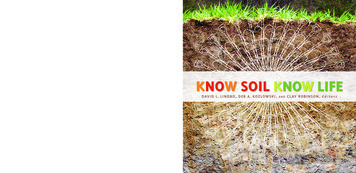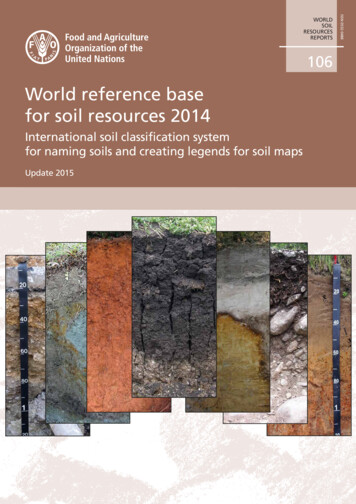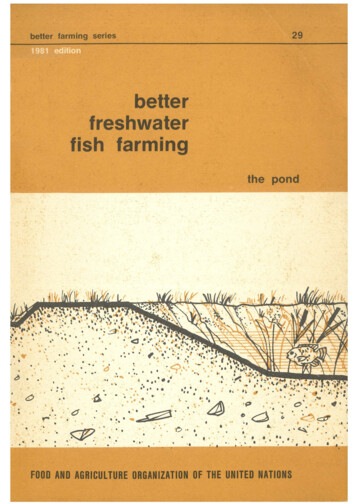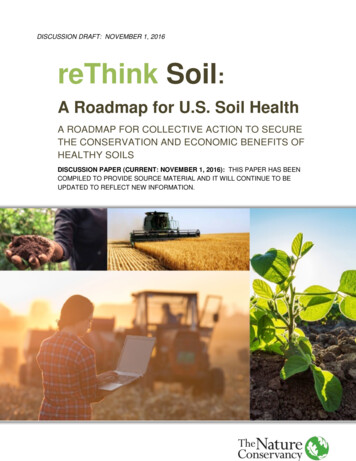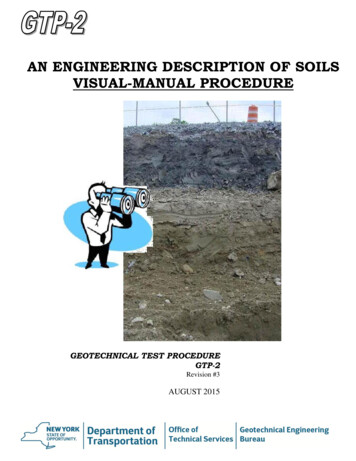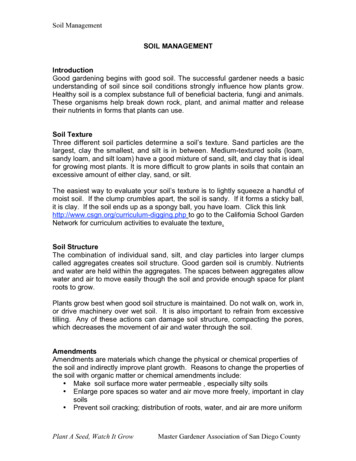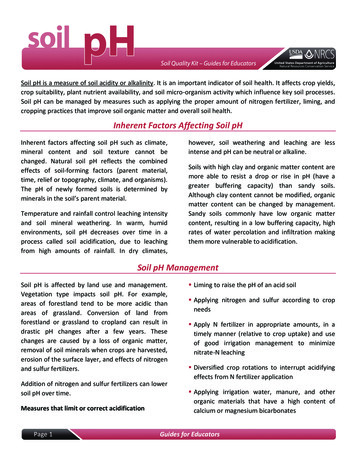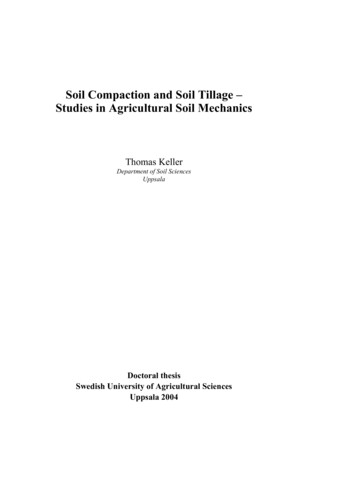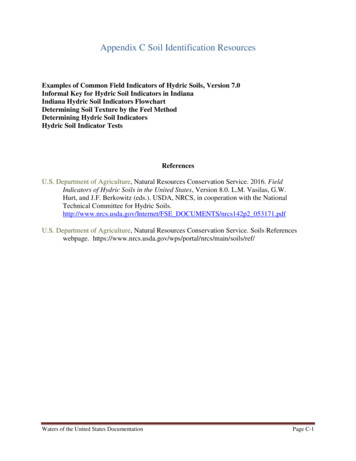
Transcription
Appendix C Soil Identification ResourcesExamples of Common Field Indicators of Hydric Soils, Version 7.0Informal Key for Hydric Soil Indicators in IndianaIndiana Hydric Soil Indicators FlowchartDetermining Soil Texture by the Feel MethodDetermining Hydric Soil IndicatorsHydric Soil Indicator TestsReferencesU.S. Department of Agriculture, Natural Resources Conservation Service. 2016. FieldIndicators of Hydric Soils in the United States, Version 8.0. L.M. Vasilas, G.W.Hurt, and J.F. Berkowitz (eds.). USDA, NRCS, in cooperation with the NationalTechnical Committee for Hydric Soils.http://www.nrcs.usda.gov/Internet/FSE DOCUMENTS/nrcs142p2 053171.pdfU.S. Department of Agriculture, Natural Resources Conservation Service. Soils Referenceswebpage. ls/ref/Waters of the United States DocumentationPage C-1
Examples of Common Field Indicators of Hydric Soils, Version 7.0*IndicatorTypeDescriptionA1, Histosol 16 inches of the upper 32inches is organic materialA2, HisticEpipedonA histic epipedon, 8 inches oforganic material underlain bymineral soil with low chromaChroma 2 or lessA10, 2cmMuck 0.75 inches much layerstarting within the upper 6inchesA layer with a depleted matrix(DM) or gleyed matrix startingwithin 12 inches of the soilsurface that has a minimumthickness of 6 inches.Value 3 or lessChroma 1 or lessDM is 60%, chroma 2or less; gleyed matrix,layers above must becolor 3/21 or less, 3/1 orless for sandsPreviously F4. ForFragmental andsandy soil materialrefer to Version 6.0A12, ThickDark SurfaceA layer with a DM or gleyedmatrix, 6 inches thick startingbelow 12 inches of the soilsurface.Dark surface: upper 12 inches is2.5/1 or less and remainder is3/1 or lessDM is 60%, chroma 2or less; gleyed matrixPreviously F5. Forsandy soils refer toVersion 6.0S1, SandyMuckyMineral 2 inches of mucky modifiedsandy mineral layer startingwithin the upper 6 inchesF1, LoamyMuckyMineral 4 inches of mucky modifiedmineral layer starting within theupper 6 inchesA DM is either: 2 inch thick within the upper6 inches orA11, DepletedBelow DarkSurfaceF3, DepletedMatrixColorsNoteClassifies as aHistosol“mucky” is a USDAtexture modifier formineral soils 60% chroma 2 or lessE horizons withoutRC are excluded;refer to Version 6.03/1 or less and 2% RCor3/2 or less and 5% RCRC are the reddish,brownish andyellowish colors(previously calledmottles) 6 inch thick starting withinthe upper 10 inchesF6, RedoxDark Surface 4 inch thick layer entirelywithin the upper 12 inches ofmineral soil. All redoxconcentrations (RC) must bedistinct or prominent.NOTE – For all depleted matrixes, RC are required for: 4/1, 4/2, and 5/2 matrix colors.* Refer to the latest version of the NRCS Field Indicators of Hydric Soils for official use.Waters of the United States DocumentationPage C-2
Informal Key for Hydric Soil Decisions in Indiana, Sept. 2012See Field Indicators of Hydric Soils in the United States (v. 8.0) for details.This key is written to help navigate Field Indicators of Hydric Soils in. the United States (v. 8.0).1. Does the top layer the top layer have a dominant chroma 2 and is more than 6 inches thick?YES you will not make any indicatorNO go to 22. Is the soil muck? Muck is sapric organic soil material in which virtually all of the organic material isso decomposed that identification of plant forms is not possible:YES go to 3NO go to 7All soils, mainly thick organic matter accumulation.3. Is the soil a Histosol (16 inches of organic material in the top 32 inches)?YES hydric (A1)NO go to 44. Is there a layer of muck 2 centimeters starting within 6 inches of the soil surface?YES go to 5NO go to 65. Is there a layer of muck 8 inches thick starting within 6 inches of the soil surface?YES hydric (A2)NO hydric (A10) in LRR M and N6. Are there several stratified layers within 6 inches of the soil surface and 1 or more layers ( 3/1)and/or is muck or mucky modifier?YES hydric (A5)NO go to 77. Is the top 10 inches of the soil loamy sand or coarser? This includes lfs, ls, lcos, vfs, fs, s and cos.YES got to 8NO go to 13Sandy soils (loamy fine sand and coarser). These include lfs, ls, lcos, vfs, fs, s and cos.8. Is there 2 inches of mucky sand within the upper 6 inches of the soil?YES hydric (S1)NO go to 99. Is there 2 inches of mucky peat or peat within the top 6 inches of soil with (value/chroma of 3/2 ordarker)?YES hydric (S3) in LRR MNO go to 10Waters of the United States DocumentationPage C-3
10. Is there a layer with 60% gley page colors within the upper 6 inches of the soil?YES hydric (S4)NO go to 1111. Is there a 4 inch thick layer within 6 inches of the soil surface with 2% bright mottles? The matrixchroma is 2 (any value) and the mottles are distinct or prominent.YES hydric (S5)NO go to 1212. Within the upper 6 inches of the soil surface is there a layer or gray splotchy colors, with Value 5 ormore? [no thickness requirement]YES hydric (S5)NO go to 13Loamy and fine soils (loamy very fine sand and finer). Includes: loamy very find sand, sandy loams,loam, silt loam, silt, sandy clay loam, clay loam, silty clay loam, sandy clay, silty clay and clay)13. Does the soil have a Depleted Matrix* immediately below the topsoil with any of the combinationsof topsoil depths and colors described in Table 1 & Figure 1 below?YES hydricNO go to 14Table 1. For Soils with a Depleted Matrix immediately below the topsoilDepth to the Topof Layer withDepleted Matrix1 to 4 inches4 to 6 inches 6 to 10 inchesRequiredThickness ofDM2 inches6 inches6 inches 10 to 12 inches 12 inches6 inches6 inchesValue/ Chroma of topsoilabove DMNRCS FieldIndicatorAnyAny3/2 or darker, but up to 6 inches ofthe topsoil can be any color3/2 or darkerTop foot is 2.5/1 or darker andbelow is 3/1 or darkerF3F3F3A11A12*A Depleted Matrix is a layer with dominantly gray colors, usually with bright mottles, in combinations per Figure 1.Matrix colors are in the upper left side of the color chart (4/2 and upward to the left). Applies to other color charts, also(e.g., 2.5Y, 5Y, 7.5YR, etc.). Mottles, if required, are red or brown (redox concentrations); at least 2% abundance; and aredistinct or prominent Mottles are required for color chips 4/1, 4/2, and 5/2. Mottles are optional for color chips 5-8/1 and6-8/2. The Depleted Matrix is for use with Loamy and Clayey textured soils.Waters of the United States DocumentationPage C-4
With or without redoxconcentrations/ bright mottles2% or more distinct or prominentredox concentrations/ bright mottles14. Is there 4 inches thick with “mucky” organic matter content (for example, mucky loam, mucky silt loam,mucky silty clay loam, etc.) starting within 6 inches of the soil surface?YES hydric (F1) except LRR NNO go to 1515. Does the topsoil (3/2 or darker) have a mottled layer 4 inches thick all within the top 12 inches of the soil,with an of the combinations of topsoil colors and mottle abundances described in Table 2 below?Table 2. For Soils with Mottles in the top foot of a dark topsoilTopsoil MatrixValue/Chroma3/1 or darker3/2 or darkerPercent red mottles (Fe concentrations)(distinct or prominent)2 percent (F6)5 percent (F6)Percent gray mottles (Fe Depletions)Value 5/Chroma 210 percent (F7)20 percent (F7)YES hydricNO go to 1616. Is there a layer with 60% gley page colors within the upper 12 inches of the soil surface?YES hydric (F2)NO go to 1717. Is the soil in a closed depression subject to ponding AND there are 5% bright distinct or prominent mottles(redox concentrations) in a layer 2 inches thick entirely in the top 6 inches of the soil?YES hydric (F8)Waters of the United States DocumentationPage C-5
Notes: Redox Features Types and LocationConcentrations (C) are those redox features that have a chroma of 3 or higher.Depletions (D) are those redox features that have a chroma of 2 or less.Generally the redox features will be found in the matrix (M).NOTES: TextureCoarse sand – cosSand – sFine sand – fsVery fine sand – vfsLoamy coarse sand – lcosLoamy sand - lsLoamy find sand - lfsLoamy very fine sand – lvfsCoarse loamy sand – coslSandy loam – slFine sandy loam – fslVery fine sandy loam – vfslLoam – lSilt loam - silSilt – siSandy clay loam – sclClay loam – clSilty clay loam – siclSandy clay – scSilty clay – sicClay – cSource: Field Book for Describing and Sampling Soils, p. 2-38.Waters of the United States DocumentationPage C-6
Waters of the United States DocumentationPage C-7
Waters of the United States DocumentationPage C-8
Determining Hydric Soil IndicatorsExamples of collected layer data and the appropriate hydric soil indicators.a. Layer # 1 – 0 to 24”Layer # 2 – 24 to 34”Black (10YR 2/1) muck, no redox concentrationsGrayish brown (10YR 5/2) loamy/clayey soil6% strong brown redox concentrations (7.5YR 5/6)A1, A2, A10 (intended for accumulation of organic matter), A12 (would be hard to support ifonly indicator), can see this on slopes with ground water seepsb. Layer # 1 – 0 to 11”Layer # 2 – 11 to 30”Layer # 3 – 30 to 50”Very dark grey (10YR 3/1) loamy/clayey soil, no redoxBlack (10YR 2/1) muck, no redoxGrayish brown (10YR 5/2) loamy/clayey soil6% strong brown redox concentrations (7.5YR 5/6)A1, doesn’t meet A2 or A10, not surface horizonsc. Layer # 1 – 0 to 14”Layer # 2 – 14 to 18”Layer # 3 – 18 to 25”Black (10YR 2/1) loamy/clayey soil, no redoxVery dark gray (10YR 3/1) loamy/clayey soil5% strong brown redox concentrations (7.5YR 4/6)Grayish brown (10YR 5/2) loamy/clayey soil6% strong brown redox concentrations (7.5YR 5/6)A12, not F6 (no redox in surface)d. Layer # 1 – 0 to 8”Layer # 2 – 8 to 20”Very dark gray (10YR 3/1) loamy/clayey soil, no redoxGrayish brown (10YR 5/2) loamy/clayey soil6% strong brown redox concentrations (7.5YR 5/6)F3, A11 (starting within 12” of soil surface)e. Layer # 1 – 0 to 11”Layer # 2 – 11 to 25”Very dark gray (10YR 3/1) loamy/clayey soil, no redoxGrayish brown (10YR 5/2) loamy/clayey soil6% strong brown redox concentrations (7.5YR 5/6)A11f.Layer # 1A –Layer # 1B – 0 to 6”Layer # 2 – 6 to 14”3” Fibric material (duff) on surfaceBlack (10YR 2/1) loamy/clayey soil5% strong brown redox concentrations (7.5YR 5/6)Grayish brown (10YR 5/2) loamy/clayey soil6% strong brown redox concentrations (7.5YR 5/6)A11, F3 and F6Waters of the United States DocumentationPage C-9
g. Layer # 1 – 0 to 3”Layer # 2 – 3 to 25”Very dark gray (10YR 3/1) sandy soil, no redoxGrayish brown (10YR 5/2) sandy soil4% strong brown redox concentrations (7.5YR 5/6)A11, S5 fails because of depthh. Layer # 1A –Layer # 1B – 0 to 4”Layer # 2 – 4 to 14”3” Fibric material (duff) on surfaceBlack (10YR 2/1) loamy/clayey soil, no redoxGrayish brown (10YR 5/2) loamy/clayey soilNo redox documented, described.i.Layer # 1A –Layer # 1B – 0 to 4”Layer # 2 – 4 to 14”3” Fibric material (duff) on surfaceDark grayish brown (10YR 3/2) loamy/clayey soil5% strong brown redox concentrations (7.5YR 4/6)Grayish brown (10YR 5/2) loamy/clayey soil6% strong brown redox concentrations (7.5YR 5/6)A11, F3 and F6j.Layer # 1 – 0 to 1”Layer # 2 – 1 to 6”Layer # 3 – 6 to 14”Black (10YR 2/1) muck, no redoxDark grayish brown (10YR 3/2) sandy5% strong brown redox concentrations (7.5YR 5/6)Grayish brown (10YR 6/2) loamy/clayey soil18% strong brown redox concentrations (7.5YR 5/6)A10, F3, and S5, not A11 because of 3/2k. Layer # 1 – 0 to 24”Black (10YR 2/1) loamy/clayey, no redoxMove hole, keep diggingWaters of the United States DocumentationPage C-10
Hydric Indicator TestsRick NeilsonAsst. State Soil Scientist, Indianapolis, INHorizonABtgDepth0-1111-20Indicator(s): A11A0-15Btg15-25Indicator(s): A12A0-5Btg5-25Indicator(s): F3Matrix Color%TextureMottle Color%10YR 3/210YR 4/210070SiCLSiCL10YR 5/63010YR 2/110YR 4/110070SiCLSiCL10YR 5/63010YR 4/410YR 4/210070SiCLSiCL10YR 5/630ABtg0-810YR 2/170SiCL10YR 5/68-2010YR 4/2100SiCLIndicator(s): F3, (F8 - assuming that you are in a closed depression subject to ponding.)A0-1110YR 3/3100SiCLBtg11-2010YR 4/270SiCL10YR 5/6Indicator(s): None, F3 - too deep, A11 or any other indicator - too brown in surfaceA0-510YR 3/2100SiCLBtg5-1010YR 4/270SiCL10YR 5/6Bt10-2010YR 5/2100CLIndicator(s): None, DM is not thick enoughA10-1010YR 2/1100SiCLA210-1510YR 3/1100SiCLBtg15-2510YR 4/170SiCL10YR 5/6Indicator(s): None, A12 - A2 horizon is too lightA10-310YR 3/1100SBtg3-1510YR 4/270S10YR 5/6Indicator(s): S5A0-610YR 2/1100SLB6-2010YR 3/170SiCL10YR 5/6Indicator(s): None, no DMOa0-910YR 2/1100MuckB9-2010YR 4/470SiCL10YR 5/6Indicator(s): A2, also meets A10A0-1210YR 2/1100SB12 10YR 5/1100SIndicator(s): None, no DMA0-1010YR 3/275SiL10YR 5/2B10-1510YR 4/370CL10YR 5/6Indicator(s): F7Waters of the United States Documentation303030303030302530Page C-11
mineral soil with low chroma Chroma 2 or less A10, 2cm Muck 0.75 inches much layer starting within the upper 6 inches Value 3 or less Chroma 1 or less A11, Depleted Below Dark Surface layers above must be A layer with a depleted matrix (DM) or gleyed matrix starting within 12 inches of the soil surface that has a minimum thickness of 6 inches.
